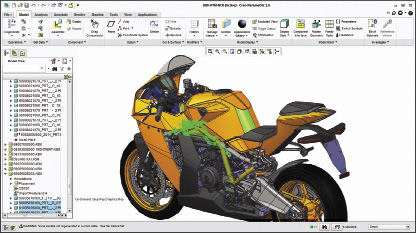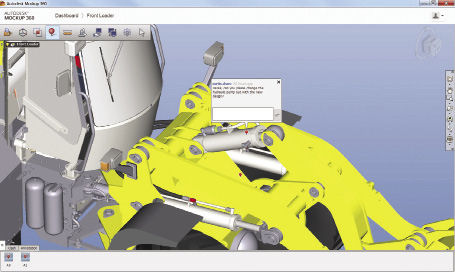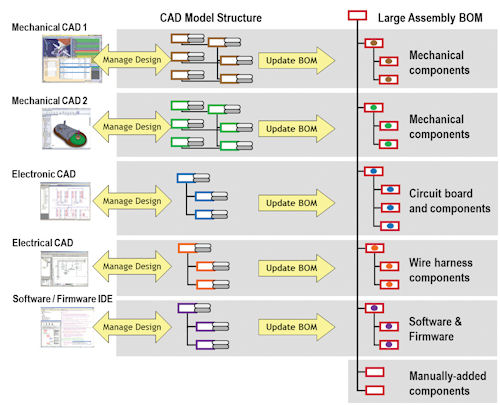Work with Large CAD Assemblies
Increasing product complexity and cross-disciplinary design are adding to the size and scope of CAD models, but new technology advances are facilitating engineers' interaction with large assemblies.
November 1, 2013
 PTC has made its Creo View lightweight design environment available from directly within Creo Parametric to ease the burden of accessing large assemblies. Image courtesy of PTC. |
In addition to ballooning assembly sizes, engineers are incorporating a richer set of material into the 3D model, such as folding in simulation results or electrical CAD data. It’s part of a trend toward creating a complete and realistic digital representation of the product. Besides electrical and embedded software content, the traditional mechanical-only CAD model is also being augmented with metadata, specifications, materials properties, cost estimates and manufacturing options, including the product configuration and variant data required for regional and individual customization of products.
While these highly detailed 3D models go a long way in streamlining the design process and reducing reliance on physical prototypes, they also open up the door to a litany of performance and workflow challenges—among them, the ability to effectively collaborate on concurrent design. According to a survey by market research firm CIMdata, more than 40% of engineers said they experienced excessive delays in loading and interacting with large assemblies, causing great frustration and sapping overall productivity.
“Ten years ago, companies developing 3D models included just enough information for engineers to communicate to the manufacturing organization how to assemble the product, but we’re creating higher-fidelity models today,” notes Brian Shepherd, vice president of product management at PTC. “Without the proper tools, engineers can really be burdened with a lot of waiting time in order to establish the design context that’s relevant for them to do their work.”
The large assembly problem goes well beyond slowing workstation performance to a crawl: The larger the assembly, the more likely that multiple engineering disciplines are involved in the design process. Thus, managing the structure and concurrency of information is a central part of the challenge, notes Paul Brown, senior marketing director for NX at Siemens PLM Software. Citing the shipbuilding industry as a specific example, Brown explains: “The people doing steel work are different than the people outfitting the piping and HVAC (heating, ventilation and air-conditioning), who in turn, are totally different than the team doing propulsion work. If you end up with a team of 200 design engineers on a vessel, the traditional hierarchical assembly structure is not going to work.”
 Autodesk Mockup 360 offers a simple way to pull together large-scale project data from many CAD sources in a real-time, cloud-based collaboration and visualization tool. Image courtesy of Autodesk. |
At issue, Brown says, is tying up the entire assembly structure simply for one team or a single functional area to gain access to their specific sub-assembly or set of components necessary to do their work. “Traditionally, you’d have to have access to the highest level where the assemblies come together so you can get the context of what you need to design,” he explains. “What that means is you have to have access and control over a lot more data, but you risk locking people out and not effectively managing the changes.”
Context Clues
Recognizing that assembly structures are only likely to get bigger and more complex, vendors are actively rolling out solutions aimed at mitigating the pain points around both system performance and concurrent design work. From the hardware side, workstation players like Hewlett-Packard, Dell and BOXX Technologies are pushing the envelope by leveraging, whenever possible, multi-processing and cache technologies—along with over-clocking capabilities to speed up the retrieval, display and navigation of large assembly models.
NVIDIA is also addressing the large assembly problem, deploying technologies like virtualization to help minimize the need to move large 3D CAD files back and forth across the network. NVIDIA is collaborating with partners like Dassault Systèmes’ SolidWorks to optimize CAD software to fully exploit the added horsepower of its graphics processing units (GPUs).
Despite the efforts of hardware and software vendors to speed up large assembly performance, they are starting to reach a point of diminishing returns, reports Ken Versprille, Ph.D., an executive consultant with CIMdata’s Collaborative Product Development Associates.
“With the pure computer science type of operations, there comes a point where you ask, ‘How much more improvement can you really get?’” Versprille continues. “They’ve already spent 10 years trying to improve their code, and they’ve milked every microsecond they can get already. Now they are starting to look for other types of solutions.”
One proven alternative to boosting large assembly performance is employing lightweight visualization technology wherever appropriate, as opposed to having to load and interact with a full-scale geometric model for every operation. Substituting a lightweight, graphics-only representation of a product component or subassembly allows engineers to view their portion of a product design in context with related areas—and in some cases, allows for some minor editing.
PTC has embraced this approach with Creo Parametric. The latest release, which incorporates the Creo View lightweight visualization technology, loads the critical graphics and structure of a model to provide the full perspective, only adding the geometry and feature history when an engineer zooms in on a particular area in the model to get a more detailed view. Siemens PLM Software takes a similar approach, integrating its lightweight JT format into NX’s data structure.
 Aras’ standardized CAD integration platform, which includes unified data and process models, delivers high performance for large assembly modeling for global multi-CAD environments. Image courtesy of Aras. |
While lightweight visualization can address some of the performance issues associated with large assemblies, most CAD providers are moving a step beyond to tackle the broader problem of allowing multiple engineering teams, including those in different disciplines, to collaborate on concurrent design. While each CAD player has a slightly different approach, the concept is pretty similar:
- allow engineers to flexibly define sections of a product assembly that are relevant to their role and work deliverables;
- eliminate the need to load the entire assembly, thus speeding performance; and
- support concurrent design via data and change management workflows.
“Just like Synchronous Technology freed up the sequential nature of the parametric history tree, 4DG frees up an assembly from the bounds of a hierarchical structure so engineers can see the bits they need to see without tying up data,” Brown adds. With 4DG, engineers build up recipes to create context for their areas of interest—defining, for example, that they want to see areas of the assembly related to HVAC design, but not steel work. Based on these parameters, which can be continuously modified, NX and Teamcenter automatically load the parts of the assembly that are relevant instead of pulling in everything and then filtering out unnecessary data, he explains.
Product lifecycle management (PLM) provider Aras is also attacking the concurrent collaboration challenge with large assemblies, albeit from a slightly different angle. Aras has been architected as a standardized CAD integration platform, allowing disparate functional engineering groups to work inside a common assembly.
“Because we’ve never built any optimizations around one CAD system, we’ve been able to define a neutral representation of the CAD structure so you can have Creo and CATIA check in and check out in the same assembly,” explains Peter Schroer, Aras president. “By doing so, you allow people in a big design team to work in one assembly and have a consistent structure, workflow and data model.”
Aras is also able to leverage its native Web architecture to take advantage of techniques such as compression and multi-threading to speed up large assembly design, Schroer says.
Virtualization and the Cloud
Two of the hottest information technologies—virtualization and the cloud—are also being used to tackle the large assembly performance and collaboration problem. NVIDIA and SolidWorks have partnered to certify SolidWorks 2014 to support the new NVIDIA visual computing appliance (VCA), a turnkey GPU virtualization offering that allows workgroups on a LAN to remotely run GPU-accelerated Windows applications on any Mac, Linux, or Windows computer.
“A large assembly means more complex collaboration, and with virtualization and remoting, you can have access to designs ]and large assemblies] wherever you are,” notes Andrew Cresci, NVIDIA’s general manager of manufacturing.
NVIDIA is also working with SolidWorks to optimize SolidWorks 2014, to better leverage the NVIDA Kepler GPU architecture for large assemblies. In testing, the pair have achieved an average of 2x faster performance with assemblies larger than 500 components compared to SolidWorks 2013, NVIDIA claims.
For Autodesk, the cloud is essential in addressing the large assembly problem, both for increasing performance and easing cross-disciplinary collaboration. In addition to Inventor capabilities like Express Mode, which speed up assembly load times by leveraging mesh-based data stored in a cache, the company is pursuing several cloud-based options to allow dispersed engineering teams and partners to collaborate on a common assembly without sacrificing the proper change management and tracking.
MockUp 360, for example, is a real-time collaboration and digital mockup tool used to quickly aggregate large-scale 3D CAD data, enabling team members to easily collaborate on large assemblies in the cloud and track changes.
“Mockup 360 lets groups use any CAD system and contribute to a common data model,” explains Peter White, Autodesk’s product manager for 360 Mockup. “Engineers can connect anywhere in the world because it’s cloud-hosted. You simply position your data in the context of the design, and the software translates it and integrates it into the overall product architecture.”
The just-released Autodesk Remote, a cloud service that lets users drive their Autodesk applications on their primary computer from a remote PC or iPad, will help address system performance issues when accessing native design data, he adds.
Even with the breadth of new solutions, it’s safe to say that software and hardware vendors will continue to chip away at the large assembly problem—although it’s unlikely to let up anytime soon.
“It’s a challenge, and it’s something we are continuing to focus on,” says Bill Lewis, director of product marketing for Teamcenter at Siemens PLM Software. “We don’t consider it solved by any stretch.”
Beth Stackpole is a contributing editor to DE. You can reach her at [email protected].
More Info
Subscribe to our FREE magazine, FREE email newsletters or both!
About the Author
Beth Stackpole is a contributing editor to Digital Engineering. Send e-mail about this article to [email protected].
Follow DE





